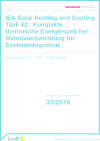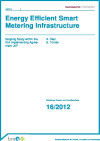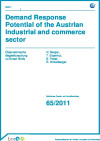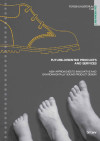Suchergebnisse für "Factsheet%3A Energietechnologien gestalten%2C die f%C3%BCr alle sinnvoll und nutzbar sind"
Product Service Systems Water
Based on former FdZ projects in the area of PSS, EMA and Zero Emission PSS Water develops and realises a guideline with which sustainable water management in industry and public utiliies as a service can be offered.
Feed-in and system integration of biogas in existing gas grids
Method for assessment of technological aspects of biogas supply to existing gas grids. Definition of characteristic numbers for quantitative an qualitative analysis. Aspects of systems integration.
Integration of decentralised renewable energies in existing fossil district heating grids
Analysis of potentials as well as technical / economical and organisational solutions to integrate decentralised heating power production from renewables into existing fossil heating grids.
Sustainability Skills - A qualification programme for founders of new businesses
A modular and web-based "Sustainability Skills" qualification programme on how to think, plan, and act in terms of sustainability and how to successfully apply these skills in a business environment.
Scenario assessment for the economic market potential of relevant energy technologies.
Economic analyses and scenarios for the future relevance of various sustainable energy technologies considering interaction of technologies, learning effects and exogenous scenario parameters. Recommendations for the future orientation of research and technology development.
IEA Solar Heating and Cooling Task 42: Kompakte thermische Energiespeicher - Materialentwicklung für Systemintegration

Schriftenreihe
32/2016
Gerald Steinmaurer
Herausgeber: BMVIT
Deutsch
Downloads zur Publikation
Energy Efficient Smart Metering Infrastructure

Scoping Study within the IEA Implementing Agreement "4E"
Schriftenreihe
16/2012
A. Diaz, S. Tomek
Herausgeber: BMVIT
Englisch, 87 Seiten
Downloads zur Publikation
Demand Response Potential of the Austrian industrial and commerce sector

Österreichische Begleitforschung zu Smart Grids
Schriftenreihe
65 /2011
H. Berger, T. Eisenhut, S. Polak, R. Hinterberger
Herausgeber: BMVIT
Deutsch, 291 Seiten
Downloads zur Publikation
Multimedia
DDM Feldkirchen
Demonstration of digitalization measures in heating networks using the example of Feldkirchen district heating network
Energy Workshop Northern Waldviertel

A local " integrated" energy program - successful implementation through research cooperation
Forschungsforum
1/1996
Herausgeber: BMVIT
Englisch, 6 Seiten
Future-Oriented Products And Services

New Approaches to innovative and environmentally sound produc design
Forschungsforum
1/1998
Herausgeber: BMVIT
Englisch, 6 Seiten
Downloads zur Publikation
ENUMIS - Energetic effects of urban manufacturing in the city
The project examines the challenges of urban manufacturing (UM) from the energy perspective and shows opportunities arising from the implementation of UM concepts for the future design of sustainable energy systems for cities.
Biogas as Vehicle Fuel - Economic Feasibility in Austria
The main objectives of this project are to discuss the economic feasibility of the production and distribution of biogas used as transportation fuel and to identify those types of local distribution systems that are already economically feasible under the present economic conditions in Austria.
CityCalc - Calculation Tool for Energy-Efficiency in Urban Planning
To assess the energy performance of urban planning projects in early design stages with low input and evaluation effort within the project CityCalc, an easily applicable planning and evaluation tool has been developed.
Circular Economy Compass (KLW-Komp)
The Circular Economy Compass project has developed a responsive online self-assessment tool for the circular economy in SMEs. Based on a theory-based evaluation scheme, it is be possible to determine a company's degree of preparedness for a circular economy at a reasonable cost. To this end, the tool has a computational logic that automatically generates a circularity score (KPI, Key Performance Indicator) based on the answers.
AR-HES-B – Energy storage, production and recovery of valuable substances in wastewater treatment plants
AR-HES-B develops technologically based concepts of municipal wastewater treatment plants in order to convert them from energy consumers into a hybrid energy provider, energy storage and a provider of resources. The concept enables wastewater plants to turn into an important platform in the regional energy and mass transfer.
Connection of innovative strategies and technologies to a holistic, resources-friendly plus energy building (FUTUREbase)
On the basis of a construction project in Giefinggasse 4 in Vienna the combination of new, innovative strategies and technologies to an integrated, resources conserving plus energy building with high signaling and multiplication effect had been tested for feasibility. A regional, energetical bond between the buildings TECHbase, ENERGYbase and the Klima-Windkanal had been developed.
The Sahel Project

Silicate technology for the improvement of water uptake and nutrient storage in marginal soils
Forschungsforum
1/2006
Herausgeber: BMVIT
Englisch, 6 Seiten
Downloads zur Publikation
Carless Tourism In Austria

The valleybus project Lungau, Murau, Nockgebiet - an innovative pilot scheme
Forschungsforum
3/1995
Herausgeber: BMVIT
Englisch, 6 Seiten
